Amy: Hey Chris, Amy here. Just arrived at the Recreation Hall.
Chris: Okay.
Amy: Okay, well…see you later.
Chris: Okay, bye.
Normal enough work-related phone call, right? But take a look at the reasons for it, and it’s a perfect example of a workplace relationship devoid of trust.
You see—
Amy, (a stellar employee), was calling her boss to tell him that she’d reached an offsite location. A location she visited several times a week as part of her regular duties.
Chris had demanded that Amy confirm her arrival every time she set foot in the Rec Hall. So, she’d arrive, make a beeline to the landline and call her boss.
Talk about micromanagement.
Amy felt she wasn’t trusted. And it impacted her well-being, her performance, and her relationship with her boss and coworkers.
Trust is everything.
That’s why we wanted to find out more about trust at work. ResumeLab surveyed 1000+ American employees’ thoughts on trust in their workplaces.
We dissected the anatomy of trust at work and found:
- 56% had left a job because they didn’t feel trusted.
- 63% said that a lack of trust at work had affected their mental health.
- 54% said trust has to be earned by a new manager, vs. 46% who trust them on day one.
- 73% said their workplace used computer monitoring software.
So, how are trust levels at work these days?
An abundance of trust in the workplace
In the age of the Great Resignation and r/antiwork, we expected trust to be in short supply. We were wrong.
The trust is off the charts, folks.

It’s clear that there’s a high level of trust at work for those who took part in the survey.
Before we dig into the data, we should define trust.
According to Merriam-Webster:
Trust is, “assured reliance on the character, ability, strength, or truth of someone or something”
What about trust in the workplace specifically? PricewaterhouseCoopers says this:
“Data protection and cybersecurity, treating employees well, ethical business practices and admitting mistakes top the list for consumers, employees, and business executives.”
Now that we have the full picture on what trust means, let’s see how much trust the survey takers felt at work.
They apparently felt a lot of confidence in the people at work, including their bosses, peers, and senior management.
- 91% trusted their manager.
- 85% trusted colleagues at the same level of seniority as them.
- 81% had trust in senior management and executives.
These numbers were much higher than we expected. Out of 1116 survey takers, just 100 people didn’t trust their manager.
Survey takers trusted their senior managers and executives the least, but that stands to reason, it’s not easy to trust people you don’t have much communication with.
But overall, trust levels are pretty healthy. And this at a uniquely disruptive time, when we might expect trust levels to be bottomed out.
So why were these employees feeling so confident with those they worked with?
Perhaps it’s precisely because of the unique times we live in.
A report by the Edelman Trust shows that currently the most trusted institution is business. Their global study shows that business is more trusted than government, NGOs, and the media in 18 of 27 countries.
The study shows that 75% of people trust their employer, and levels go down for other institutions after that.
They also state that business is the only institution that’s seen as “both competent and ethical.”
Trust at work boosted since pandemic
To explore this further, we asked, “Do you think trust in your workplace has increased or decreased since before the pandemic?”

- 65% of respondents said they felt trust in their workplace had increased
A study by PricewaterhouseCoopers (PwC) had this stat: 80% of employees trust their company the same or more now than before the pandemic.
Their study also showed that 84% trusted their direct manager the same or more since the pandemic started.
So, there’s a lot of trust going around in 2022.
But, there’s one group that isn’t feeling that warm-n-fuzzy sentiment.
Less education meant lower levels of trust
Interestingly, the group that trusted people at work the least were those without a college degree.
Out of this group:
- 76% trusted their direct manager.
- 70% trusted colleagues at the same level of seniority as them.
- 65% trusted senior managers and executives.
That’s quite a difference from the overall group percentages of 91%, 85%, and 81% respectively.
This could be due to something called degree inflation. Harvard Business School defines it as, “the practice of seeking a candidate with a four-year college degree for a position currently held by someone with a high school diploma or an associate’s degree.”
In other words, it’s about insisting candidates be overqualified for a job in terms of their education level.
According to HBS:
“Employers disqualify all those who might have the skills—and not just the college degree—to do that job… One of the major causes, if not the leading cause, of degree inflation is an employer’s perception that workers without a degree are not capable of performing more of today’s middle-skills tasks.”
That perception translates to a lack of trust.
Companies are excluding those without a college degree from work and promotions. Work they’re more than capable of performing. It’s no wonder their trust level is lower if employers are not entrusting them with work they’re capable of.
But, there’s something else that can deplete trust levels.
Big brother at work
“Privacy is not something that I'm merely entitled to, it's an absolute prerequisite.”
Research shows there’s been a spike in companies using computer monitoring since the start of the pandemic. The justification is to mitigate what’s being called cyberslacking. In other words, they don’t want you browsing Amazon while you’re supposed to be working.
So, how is remote computer monitoring conducted? These are the most common techniques:
- Screen monitoring—records video or static images at regular intervals. They may collect images all the time or only while you’re using the computer.
- Printer monitoring—records what’s printed from the computer.
- Data monitoring—tracks the content of files stored on the local hard drive.
- Keystroke monitoring—tracks the number of keystrokes every minute.
- Removable drive monitoring—tracks external devices connected to the computer.
- Idle time monitoring—tracks the amount of time the computer is idle.
- Video/audio monitoring—records and takes snapshots from the webcam and microphone and broadcasts it live.
It’s enough to give you the heebie-jeebies.
How many respondents thought their computers were monitored, and how did they feel about that?

A whopping 73% of those in the study reported that remote monitoring software was on their work computers. Truly, the pandemic has made remote monitoring much more commonplace.
Another paper titled, “Monitoring Remote Workers” reiterates the above:
“More employees are working from home, and more employers are keeping an eye on them through use of remote monitoring technologies… Monitoring tools also help companies enforce data security policies, and even take photos to see whether workers are sitting at their laptops at home.”
Take photos to see whether workers are sitting at their laptops?!
Now, if that doesn’t erode trust, I don’t know what does.
Surveillance is one of the major ethical dilemmas of our times. On one hand, it can improve human behavior. But when used in a draconian fashion at work, it can damage employee trust and make them less committed to their employers.
Despite this, only 52% of our respondents expressed some level of concern about being monitored at work.
It seems that remote computer surveillance has become normalized
As stated in “Electronic Monitoring and Surveillance in the Workplace:”
“Surveillance is thus a taken-for-granted element of working life. Employees expect to have their performance reviewed, objectives set, and information gathered on their activities—indeed, this is seen as good management practice. Employers are entitled to monitor their employees to ensure that resources are used efficiently, to protect commercial confidentiality and management risk, and to ensure that laws are complied with and that no crimes are committed by their employees.”
Those without a college degree (37%) were much less concerned about computer surveillance than degree holders (55%).
This most likely stems from the degree inflation mentioned earlier. Those who don’t have college degrees aren’t getting the white-collar jobs they used to. They’re relegated to more menial jobs in which computer software monitoring is less customary.
Regardless, knowing your computer activity is being monitored naturally causes some level of paranoia.
On second thought…delete!
When you feel someone is looking over your shoulder, so to speak, it affects your behavior.
More than half of those in the study were concerned enough to delete messages on workplace communication channels.
- 60% had deleted an instant message out of fear of it being read
Interestingly, those who worked in larger workplaces were least concerned about their instant messages. There was a clear correlation between the percentages of those who deleted messages and the number of employees in a workplace.
- Worked at a company with 1-2 employee workplace—80% had deleted texts
- 3-5 employee workplace—73% had deleted texts
- 6-10 employee workplace—66% had deleted texts
- 11-20 employee workplace—46% had deleted texts
- 20+ employee workplace—26% had deleted texts
Most likely, those in larger companies feel protected by the volume of texts—surely theirs will be lost in the shuffle and not noticed.
But—
Large companies and corporations are often reading employees’ texts. Larger companies have the revenue to install these programs and IT teams to check the data.
Along those lines, blocking social media sites is becoming more common. In fact, 70% in our study said that their employers blocked sites such as Facebook, Twitter, and Instagram.
Doesn’t make it that convenient to post your latest selfie, huh?
So, with all this computer monitoring, how can employees feel trust in their workplace. It boils down to an exchange of trust between managers and their employees.
How managers and employees can build mutual trust
“Trust is earned when actions meet words.”
Did the respondents agree with the words of wisdom above? We presented them with a list of factors that could contribute to trust and asked them which ones were the most important.
And, yes, words matching actions was a key factor in building trust.

Being reliable and working hard and delivering on their goals were in the top three for both managers and employees.
One left-field selection that made it to the list of ways employees can build trust with their managers was telling:
“Agreeing with everything their manager says.”
We didn’t include this in the infographic, because it’s not actually good advice. But it did make its way into the top five, meaning sometimes employees feel it’s best to just smile and nod.
Harvard Business Review’s “Rebel Talent” paper tackles the idea that we often feel afraid to break the rules and disagree in the workplace and other institutional settings:
“Nearly half the respondents reported working in organizations where they regularly feel the need to conform, and more than half said that people in their organizations do not question the status quo. Conformity at work takes many forms: modeling the behavior of others in similar roles, expressing appropriate emotions, wearing proper attire, routinely agreeing with the opinions of managers, acquiescing to a team’s poor decisions, and so on. And all too often, bowing to peer pressure reduces individuals’ engagement with their jobs.”
Employers, take heed.
The survey takers clearly expressed that always agreeing with management is a way to increase trust.
But the HBR paper also emphasizes that employers should promote constructive nonconformity. That is, employees should be allowed to express themselves in non-traditional and authentic ways, thereby increasing their engagement and trust.
We also got some valuable insights from an expert on trust in the workplace. Ron Carucci.
Ron is a co-founder and managing partner at Navalent. He’s also the best-selling author of eight books, including the award-winning To Be Honest: Lead with the Power of Truth, Justice and Purpose. He’s a regular contributor to the Harvard Business Review and Forbes, plus a two-time TEDx speaker.
“To earn and keep trust, leaders must accept that reliability and integrity are merely table stakes. They don’t, on their own, earn you a reputation of being trustworthy.
Fewer moments impact trust more than when someone’s efforts fall short. People inherently trust others they feel no need to hide from, especially in the shame of failure. When others make mistakes, even substantial ones, make sure that accountability includes keeping their self-respect intact. Balance expressing your disappointment with making sure you remain an ally, doing whatever you can to help them get back on track.”
When trust is lacking, people simply hand in their resignations.
Lack of trust fuels resignations
“Trust cannot thrive in an environment where we preach teamwork and cooperation, but seldom recognize or reward it.”

More than half of the respondents had left a job due to feeling a lack of trust. And the higher a respondent’s education level, the more likely they were to have quit because of it.
Who had quit due to feeling a lack of trust?
- 66% of Masters or doctoral students
- 57% of Associates or Bachelors grads
- 37% of those with no college degree
Those who hadn’t gotten a college degree are quitting. But, most likely, not because of a “lack of trust.”
As lack of a degree often equals a lower-paying job, quitting is often due to wanting a pay increase or poor working conditions.
But ultimately, trust is a strong factor in whether an employee stays at a job.
In a study on why employees resign, trust was one of the main criteria linked to the likelihood of quitting. And they found that the way leaders conducted themselves was the most critical factor of all.
Resignations were strongly linked to the statements expressed below:
- I feel there is a lack of trust and confidence in organizational leadership about the stewardship of the organization.
- I feel that organizational leaders act unfairly.
- I feel that there is a lack of transparency and communication during times of significant organizational change, i.e., informational injustice.
All of the above point to one thing: trust.
Wrapping up
Although trust at work is generally alive and well for the survey participants, there are certain things that make trust diminish. Computer monitoring is one of them.
Employees know what it takes to maintain and build trust. Actions that match words are a big one.
Employers should take into consideration being transparent about computer monitoring practices and make sure they are staying within the legal bounds of what’s allowable. They should also make sure managers follow the wheel of trust model described in the Roffey Park report, “The Lived Experience of Trust: People’s stories of trust in the workplace:”
- Being transparent
- Being consistent
- Being personal
- Demonstrating vulnerability
- Sticking to commitments
- Appreciating others
- Listening well
- Demonstrating trust in others
In sum, trust is the foundation of every work relationship. Its importance cannot be understated.
Methodology
We surveyed 1116 respondents online via a bespoke polling tool on trust in the workplace. All respondents included in the study passed an attention-check question. The study was created through several steps of research, crowdsourcing, and surveying.
Limitations
The data we are presenting relies on self-reports from respondents. Each person who took our survey read and responded to each question without any research administration or interference. There are many potential issues with self-reported data like selective memory, telescoping, attribution, or exaggeration.
Some questions and responses have been rephrased or condensed for clarity and ease of understanding for readers. In some cases, the percentages presented may not add up to 100 percent; depending on the case, this can be due to rounding, or due to being part of a larger statistic, or due to responses of “neither/uncertain/unknown” not being presented.
Fair use statement
Don't miss the chance to share these findings—–you might regret it! If you think your audience will be interested in this information, you can share it for noncommercial reuse. All we ask in return is that you link back to this page so that your readers can view the full study.
Sources
- Ball, K. “Electronic Monitoring and Surveillance in the Workplace”
- Brower, H., Lester, S., Korsgaard, M., “A Closer Look at Trust Between Managers and Subordinates: Understanding the Effects of Both Trusting and Being Trusted on Subordinate Outcomes”
- Dumouchel, P. “Trust as an Action”
- Edelman Trust Barometer 2021
- Gino. F., “Rebel Talent”
- Harvard Business School, “Dismissed by Degrees How degree inflation is undermining U.S. competitiveness and hurting America’s middle class”
- Lutchman, A., “Factors leading to employee resignation within a professional service organisation”
- Poorkavoos, M., Hatcher, C., Smith, A. “The Lived Experience of Trust: People’s stories of trust in the workplace”
- PricewaterhouseCooper, “The Complexity of Trust: PwC’s Trust in US Business Survey”
- Reyes, A., Aquino, C., Bueno, D., “Why employees leave: Factors that stimulate resignation resulting in creative retention ideas”
![The Female Boss: How We See Women in Power [2021 Study]](https://cdn-images.resumelab.com/pages/female_boss_rluk_8.jpg)

![Who Can You Trust at Work? [2022 Study]](https://cdn-images.resumelab.com/pages/thumbnail_1.jpg)

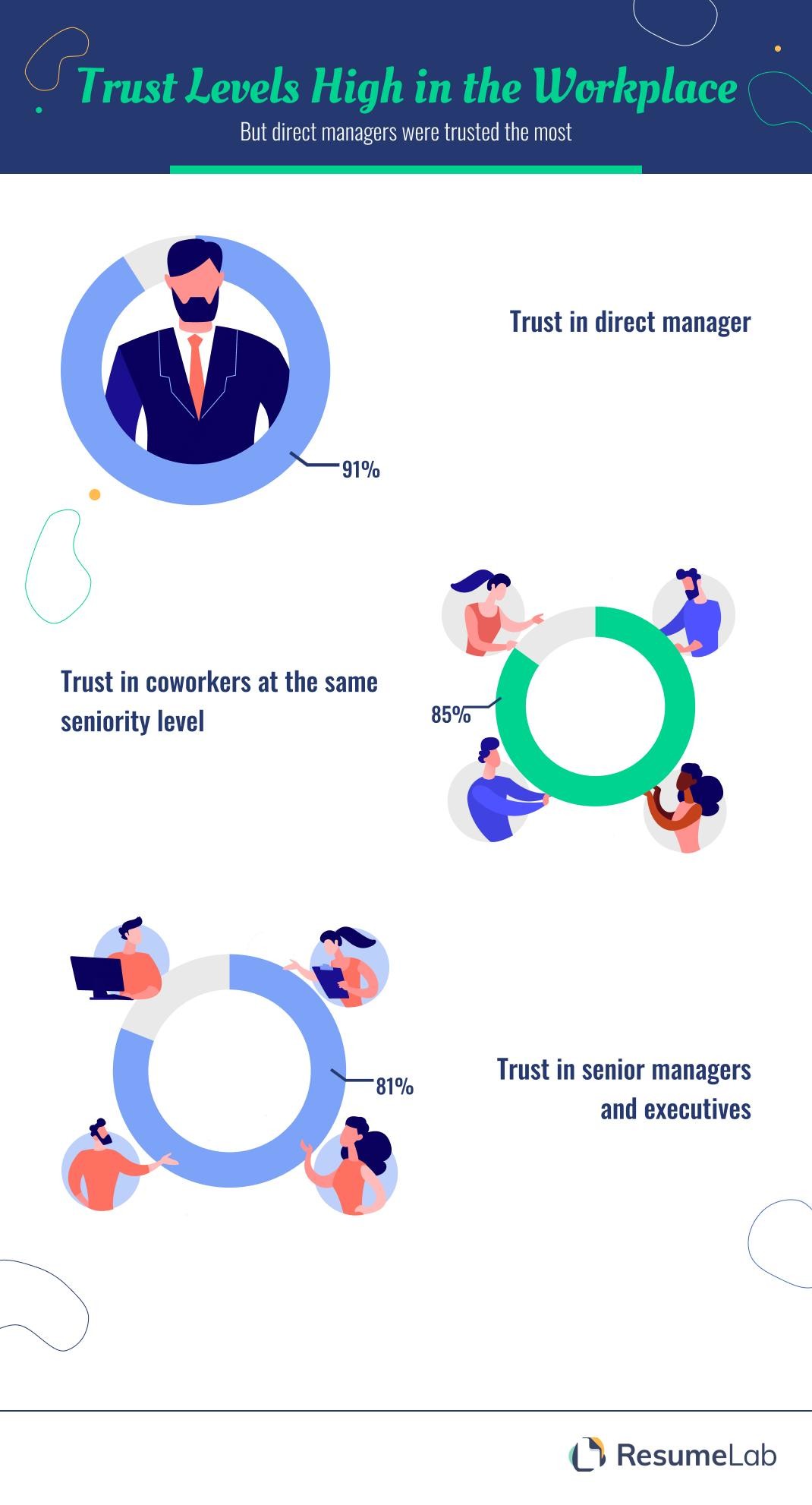
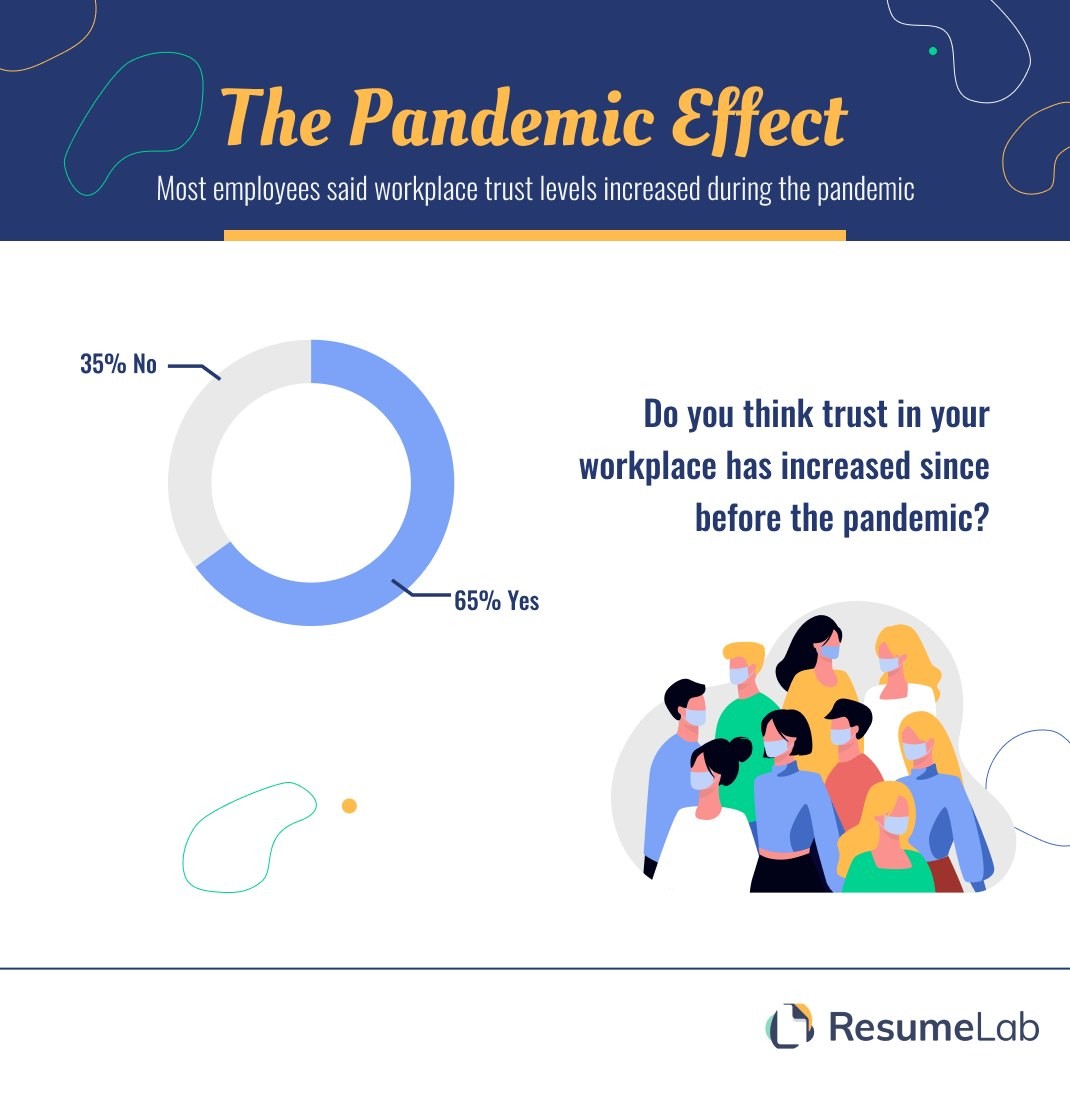
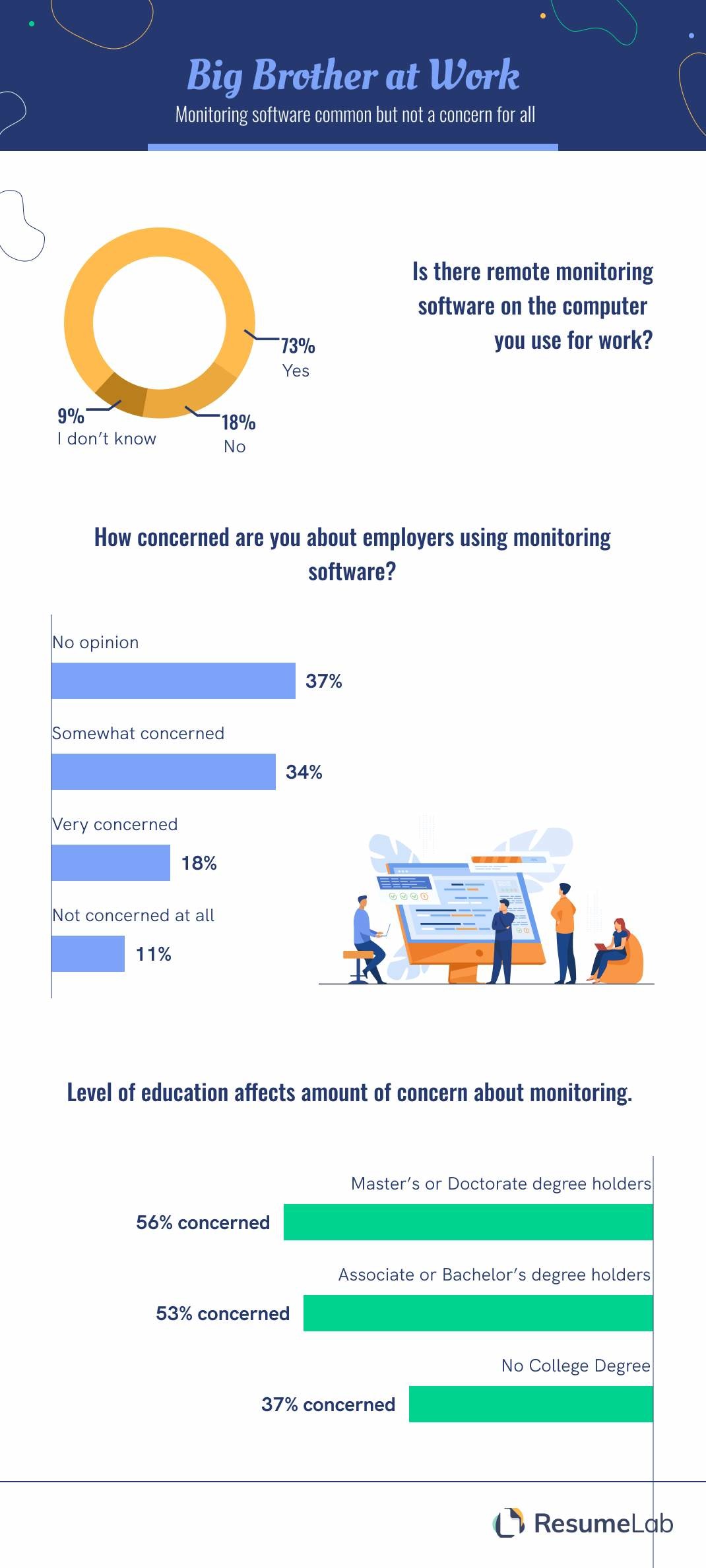
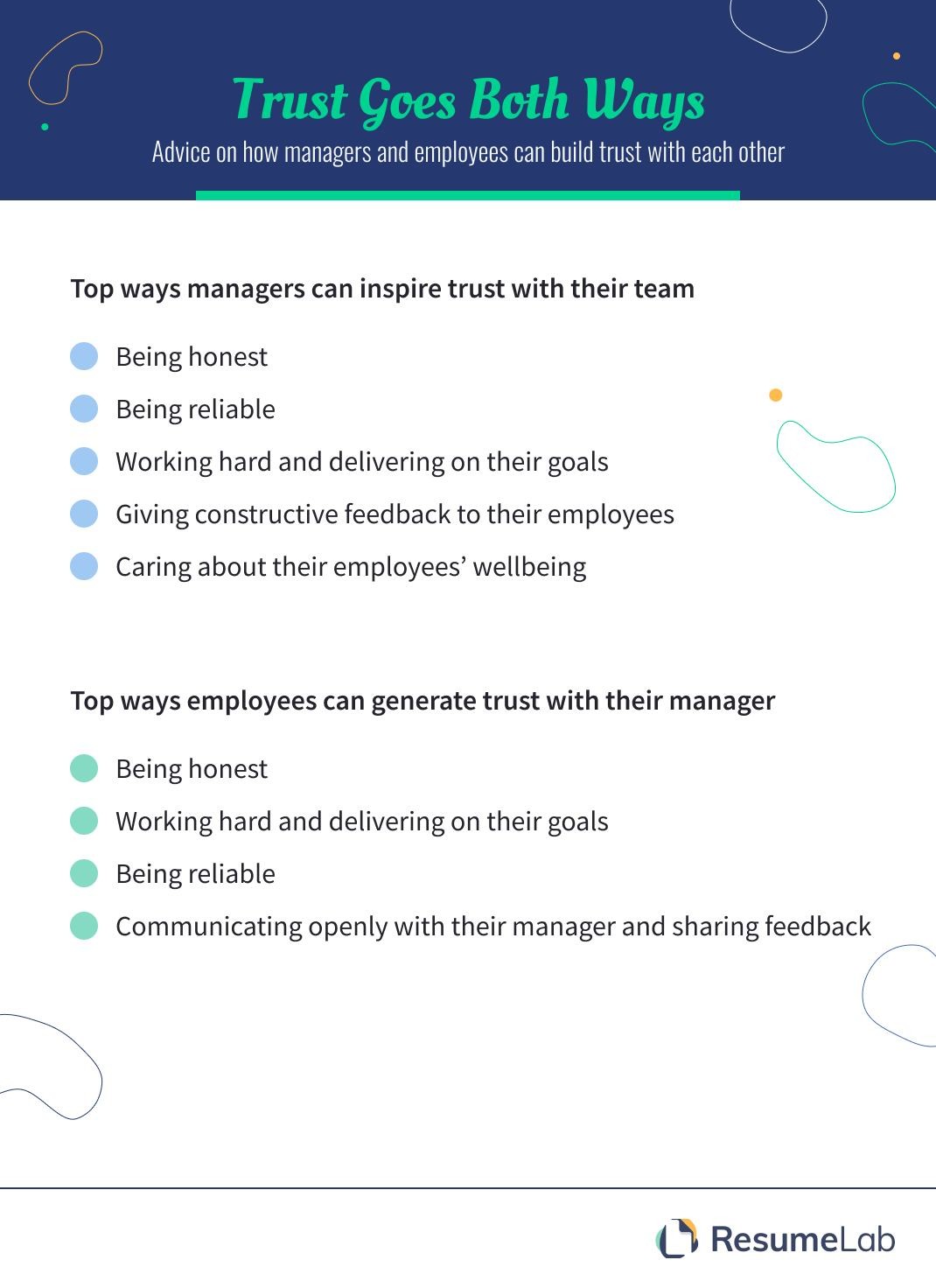
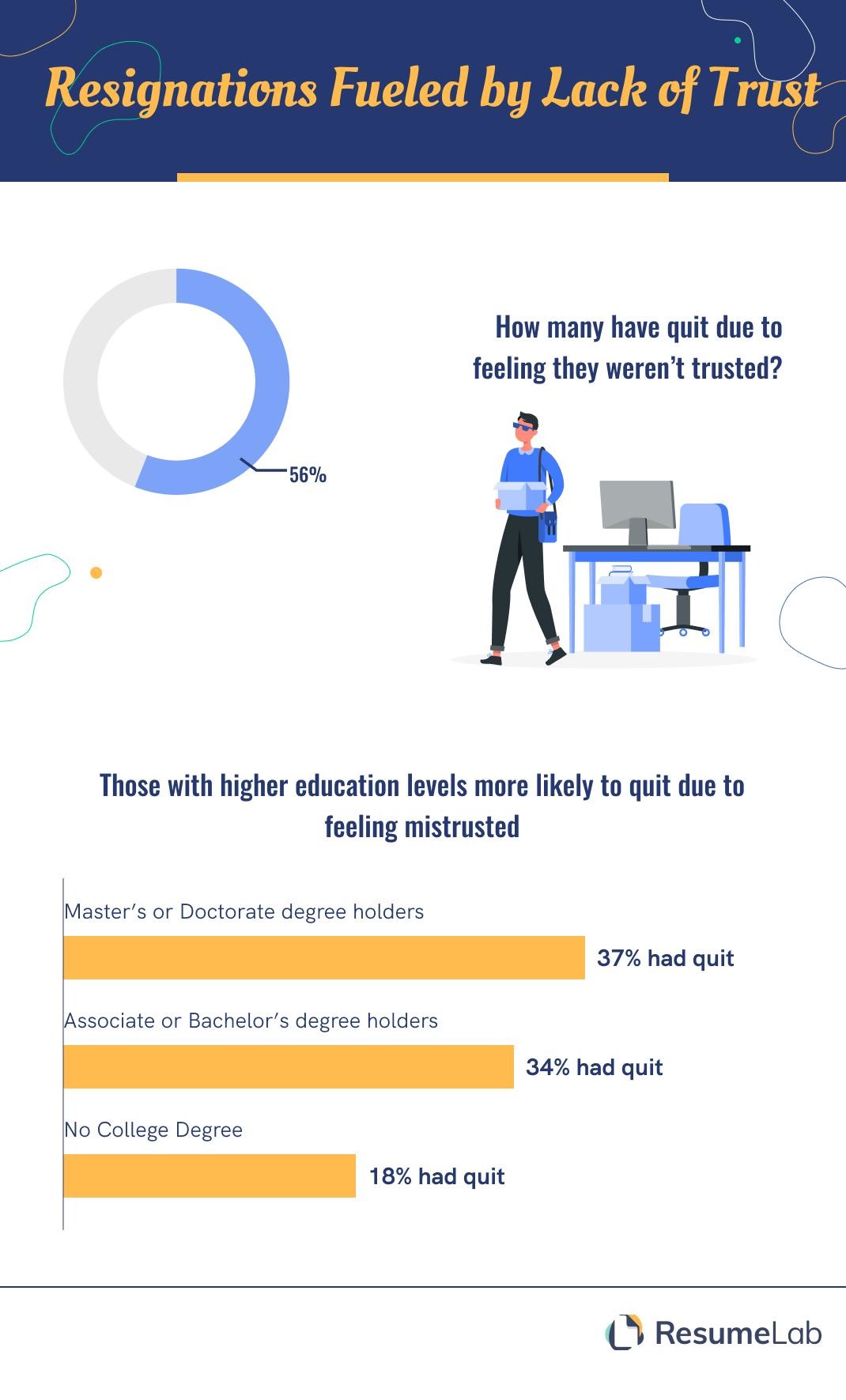
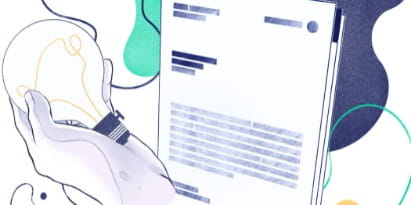
![United Stress of America [2021 Study]](https://cdn-images.resumelab.com/pages/thumbnail_1_united_stress_of_america_rlus.jpg)